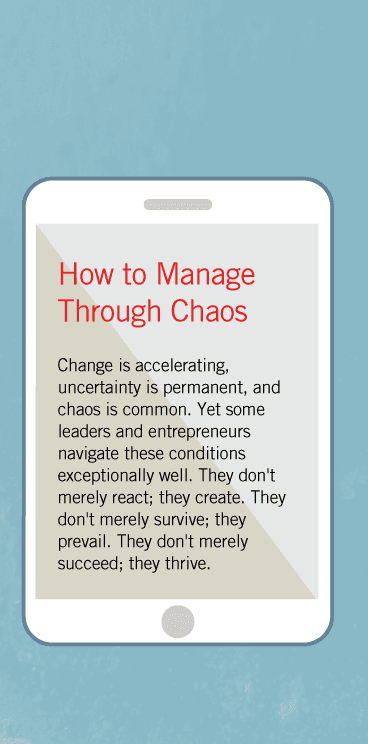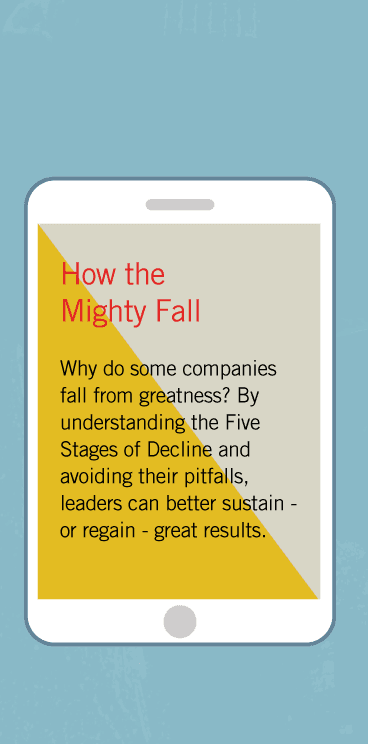It's not What You Make, it's What You Stand For
They'll need to. Business cycles of all kinds are getting shorter—some products become obsolete almost as quickly as they're created. It's more important than ever to define yourself in terms of what you stand for rather than what you make, because what you make is going to become outmoded faster than it has at any time in the past.
Then what do you hang on to? You hang on to the idea of who you are as a company, and you focus not on what you do but on what you could do. By being really clear about what you stand for and why you exist, you can see what you could do with a much more open mind. You enhance your ability to adapt to change.
Compare Zenith and Motorola, two companies that long ago were known for making TVs. Zenith stayed there; Motorola made jump after jump—to microprocessors, integrated circuits, all kinds of things—and became one of the most highly regarded companies in the country. What was the difference? Zenith thought mainly in terms of what it was making. Motorola thought mainly in terms of what it stood for. It defined its core purpose as "applying technology to the benefit of the public," not "making television sets," not even "making world-class, state-of-the-art, market-leading television sets." Motorola, by thinking about what it stood for, could give up what it made. Zenith, which never thought about it that way, couldn't.
What to do, and how your purpose
helps you choose it
Aims
like Motorola's can seem so broad that they look meaningless,
but they provide a context that drives very specific choices about
what to make or what service to provide, and whom to sell it to.
Think of Motorola again. Its large-minded conceptions of purpose
took it in directions its competitors couldn't even imagine—and
made it utterly immune to the market forces affecting TV manufacturers.
So largeness of purpose is crucial, but even apparently boundaryless notions of purpose aren't as all-inclusive as you might think. A story from my days at Hewlett-Packard shows how a broad purpose can very powerfully guide a company toward deciding what not to do.
As a junior product manager, I was part of a team charged with determining the nature of our next computer. I argued that we should do an IBM-compatible product because, given the standards in the market, if we weren't IBM compatible, we would fail. And about that I was right. What I was wrong about was that we should create the product that the market wanted, which was an inexpensive, reasonably fast IBM-compatible computer. My engineering counterparts from the lab said, "There's no opportunity for a technical contribution in a straight IBM compatible."
I said, "But that's what the market wants." And one of my friends from the lab said, "But that's not who we are. It doesn't matter if that's what the market wants. Hewlett-Packard is not about to issue a major line of computers that does not represent a technical advance, because it's not what we're about." He was right, and today HP is doing very well in a high-end, very profitable computer niche built on its high technical contribution. The company's core purpose dictated a very real-world choice.
In addition to the "what we stand for" test, there are two other key tests that help guide a company's choices about what products or services it should offer. There's a whole separate question a company must answer: What are we good at? Does the option we're considering match our capabilities? And finally, there's a third test: Will people profitably pay us for this?
Imagine a model consisting of three overlapping circles to show how the three tests inform one another. What you're after is the choice that falls inside the intersection of those three circles—the option that passes all the tests. You can see how, when seemingly unlimited possibilities are balanced by other concerns, practical choices emerge. Most companies, though, never define what they stand for; they don't have a purpose. Few companies ever even build an accurate picture of what they're good at. What they're left with is a stool supported by only one leg: they're driven only by what people will pay for.
How to describe what you stand
for—so it actually does some good
Most organizations haven't done a particularly good
job of articulating what they stand for—their "mission statements"
notwithstanding. Why is that? First, some companies don't stand
for anything real. Second, many companies that do stand for something
don't have a good grasp of what it is.
There are five important characteristics of a good expression of a company's core purpose:
One, it absolutely has to be inspiring to those inside the company.
Two, it has to be something that could be as valid 100 years from now as it is today.
Three, it should help you think expansively about what you could do but aren't doing.
Four, it should help you decide what not to do.
Last, your expression of what you stand for has to be truly authentic to your company. Companies that fail on this count are often the ones that really don't stand for anything and never will.






